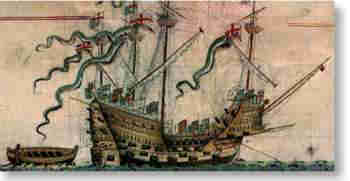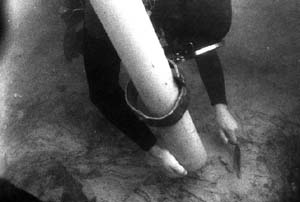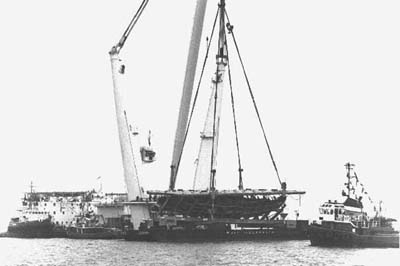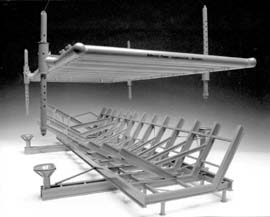The Raising of the Mary RoseThe excavation and salvage of this 16th century Tudor warship, show how underwater archaeology should be done. It also shows that such a task is a long-term undertaking, that can generate enormous public support which doesn't need to be a drain on the government's coffers.
Early salvage attempts failed and the wreck was forgotten. She was rediscovered in 1971 and the outline of the hull gradually exposed and surveyed (below). Only when this had been completed – seven years later – was a trench opened up across her bows giving archaeologists their first view of her interior. They struck it lucky. Many of the crew’s personal possessions as well as the ship’s stores were preserved in situ. The hull was also shown at this point to be salvageable.
The excavation has also honed expertise in maritime archaeology. Five hundred amateurs trained by a small team of qualified professional diving archaeologists made 28,000 dives between 1979 and 1982 alone. Their work helped prove that it is quite possible to excavate and record underwater sites to the same quality as on land. Up until 1982, the Mary Rose project cost some £2.8 million ($4.5m), financed by private sponsors – who contributed equipment, time and expertise – as well as the fund raising activities of the Mary Rose Trust and visitor income. So far more than 4.25 million people have been to see the wreck and her remarkable contents.
For 12 years after her dramatic exit, during which time the hull was turned upright and the deck structures replaced, the Mary Rose was conserved by constant spraying with chilled freshwater. In 1994, active conservation was begun using the water-soluble wax polyethylene glycol which, over 10 years, will eventually replace the water in the ship’s timbers and coat the hull. The wreck will then be slowly air-dried to remove any remaining moisture. Strict hygiene is necessary to prevent wood decay or microbiological contamination. The building in which the Mary Rose is housed includes air-conditioned viewing galleries to screen visitors from the conservation chemicals. Published in UNESCO Sources, February 1997 The restored ship is now on display in the Mary Rose Museum in Portsmouth. Related textRelated linksLiterature:Stephen Johnson: The Complete Idiot's Guide to Sunken Ships and Treasures (Alpha Books, 2000) Article published on Nordic Underwater Archaeology, Apr
'99, by permission from UNESCO |
 The Mary Rose was built between
1509 and 1511 and served in Henry VIII’s navy for 34 years until she sank off the
south coast of England on July 19th, 1545. The French claim one of their cannons sent her
to the bottom, but other evidence indicates she may simply have been overloaded or
mishandled.
The Mary Rose was built between
1509 and 1511 and served in Henry VIII’s navy for 34 years until she sank off the
south coast of England on July 19th, 1545. The French claim one of their cannons sent her
to the bottom, but other evidence indicates she may simply have been overloaded or
mishandled. The Mary Rose Trust was then formed in January 1979 "to
find, to record, to excavate, raise, bring ashore, preserve, report on and display for all
time in Portsmouth, the Mary Rose." "Although the aim was to raise the hull if
at all possible," explains Christopher Dobbs from the Trust, "the
decision to go ahead with the salvage operation was not taken until January 1982 when all
necessary information to make the decision was available. Even after that there were
various cut-off dates when the decision to halt, survey and backfill could still be
taken."
The Mary Rose Trust was then formed in January 1979 "to
find, to record, to excavate, raise, bring ashore, preserve, report on and display for all
time in Portsmouth, the Mary Rose." "Although the aim was to raise the hull if
at all possible," explains Christopher Dobbs from the Trust, "the
decision to go ahead with the salvage operation was not taken until January 1982 when all
necessary information to make the decision was available. Even after that there were
various cut-off dates when the decision to halt, survey and backfill could still be
taken."


 Back to Nordic Underwater Archaeology
Back to Nordic Underwater Archaeology